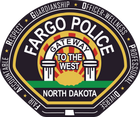Bike Safety
Fargo residents are increasingly bicycling whether it's to commute, for exercise or for fun. Bicycle safety is important to reduce the risk of injury in the event of an accident.
Every bike ride begins with putting on a helmet. But it’s equally important that you ensure a proper fit so your helmet can best protect you.
Size can vary between manufacturers. Follow the steps to fit a helmet properly. It may take time to ensure a proper helmet fit, but your life is worth it. It’s usually easier to look in the mirror or have someone else adjust the straps.
Be prepared before heading out.
- Ride a bike that fits you — if it’s too big, it’s harder to control the bike.
- Ride a bike that works — it really doesn’t matter how well you ride if the brakes don’t work.
- Wear equipment to protect you and make you more visible to others, such as a bike helmet, bright clothing (during the day), reflective gear and a white front light and red rear light and reflectors on your bike (at night, or when visibility is poor).
- Ride one per seat, with both hands on the handlebars, unless signaling a turn.
- Carry all items in a backpack or strapped to the back of the bike.
- Tuck and tie your shoe laces and pant legs so they don’t get caught in your bike chain.
- Plan your route — if driving as a vehicle on the road, choose routes with less traffic and slower speeds. Your safest route may be away from traffic altogether, in a bike lane or on a bike path.
Be focused and alert to the road and all traffic around you; anticipate what others may do, before they do it. This is defensive driving — the quicker you notice a potential conflict, the quicker you can act to avoid a potential crash:
- Drive with the flow, in the same direction as traffic.
- Obey street signs, signals and road markings, just like a car.
- Assume the other person doesn’t see you; look ahead for hazards or situations to avoid that may cause you to fall, such as toys, pebbles, potholes, grates, train tracks.
- No texting, listening to music or using anything that distracts you by taking your eyes and ears or your mind off the road and traffic.
Drive predictably so motorists get a sense of what you intend to do and can react to avoid a crash.
Drive where you are expected to be seen, travel in the same direction as traffic and signal and look over your shoulder before changing lane position or turning.
Avoid or minimize sidewalk riding. Cars don’t expect to see moving traffic on a sidewalk and don’t look for you when backing out of a driveway or turning. Sidewalks sometimes end unexpectedly, forcing the bicyclist into a road when a car isn’t expecting to look for a bicyclist. If you must ride on the sidewalk remember to:
- Watch for pedestrians;
- Pass pedestrians with care by first announcing “on your left” or “passing on your left” or use a bell;
- Ride in the same direction as traffic. This way, if the sidewalk ends, you are already riding with the flow of traffic. If crossing a street, motorists will look left, right, left for traffic. When you are to the driver’s left, the driver is more likely to see you;
- Slow and look for traffic (left-right-left and behind) when crossing a street from a sidewalk; be prepared to stop and follow the pedestrian signals; and
- Slow down and look for cars backing out of driveways or turning.
Bicycle Registration
The Fargo Police Department no longer issues bicycle licenses; however, residents are encouraged to register their bicycles through the My Property program. The online program allows you to create an account, enter information about your property such as serial numbers or pictures, and later retrieve the information if you become a victim of theft or other loss, such as a fire.

